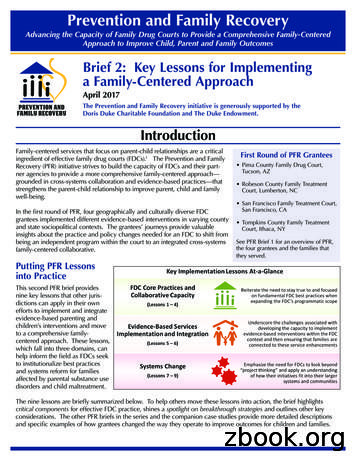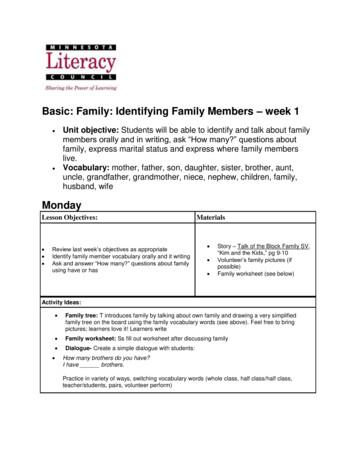Family Centered Practices In Early Childhood Intervention
Family-Centered Practices in Early Childhood Intervention:Values, Paradigms, Principles and PracticesCarl J. Dunst, Ph.D.Orelena Hawks Puckett InstituteAsheville, North Carolina, USAPresentation made at the National Federation of Voluntary Bodies “Challenging Times: Ensuring ValuesSupport Ordinary Lives” Conference, Maynooth, County Kildare, Ireland, June 22, 2011
Purpose of the Presentation Describe the role of values in early childhood intervention and howfamily-centered beliefs can be used as the foundation for parent, family,and child capacity-building intervention practicesDescribe the process one early childhood intervention program used totranslate value statements into day-to-day practices for intervening withthe parents of young children with disabilities and developmental delays
Place of Values in Programs Serving Young Childrenwith Disabilities and Their FamiliesValues are belief statements regarding how persons involved in education,human services, and other kinds of intervention programs ought to betreated by help giving professionals Paul Dokecki (1983) was one of the first professionals to propose a valueframework for developing policies and practices for strengthening families Advocates at the Center on Human Policy (1986) at Syracuse University(USA) first articulated “A Statement in Support of Families and TheirChildren” that included family strengthening practicesDokecki, P.R. (1983). The place of values in the world of psychology and public policy. Peabody Journal of Education,60(3), 108-125.Center on Human Policy. (1986). A statement in support of families and their children. Syracuse, NY: Division ofSpecial Education and Rehabilitation, School of Education, Syracuse University.
The Process of Translating Values in to PracticesThe process of translating value statements into family-centered practiceswas facilitated by “working through” the beliefs, assumptions, attitudes,and personal frames-of-mind of practitioners using benchmarks andstandards for assessing the match between values and practicesValue StatementsCapacity-Building ParadigmFamily Support PrinciplesFamily-Centered Practices
Family, Infant, and Preschool ProgramMorganton, North Carolina, USAAn early childhood intervention and family support program serving youngchildren with and without disabilities and delays that adopted, applied,revised, and evaluated the use of family-centered principles and practices forimplementing or providing different kinds of child, parent, parent-child, andfamily-level interventions, supports, and resources.
Value StatementsFIPP used value statements articulated by both the Center on Human Policy(Syracuse, NY) and the Family Resource Coalition (Chicago, IL) as well as thevalue statements described in Strengthening Families (Nicolas Hobbs et al.)and In Praise of Paradox (Julian Rappaport) to formulate a set of valuestatements that emphasized a strengths-based approach to intervention.Some examples of these value statements are: Every family member has existing strengths and the capacity to becomemore competent and there are no exceptions Every family deserves to be treated with dignity and respect at all times Families have the rightful role to decide what is in the best interest oftheir membersHobbs, N., Dokecki, P.R., Hoover-Dempsey, K.V., Moroney, R.M., Shayne, M.W., & Weeks, K.H. (1984). Strengtheningfamilies. San Francisco: Jossey-Bass.Rappaport, J. (1981). In praise of paradox: A social policy of empowerment over prevention. American Journal ofCommunity Psychology, 9, 1-25.
ParadigmsParadigms are worldviews or models for describing the key features andelements of how one thinks about, organizes, and uses the different featuresand elements of a model for conceptualizing and implementing interventionpractices. The traditional paradigm in education, human services, andhealth care has been a deficit-based approach to intervention An alternative paradigm more aligned with strengths-basedvalues is a capacity-building approach for conceptualizing andimplementing intervention practices
Family Support PrinciplesFamily support principles are belief statements about how supports andresources ought to be made available to parents and other family membersinvolved in early childhood intervention, parenting support, and familyresource programs which specify how staff should interact with and treatfamilies
Family, Infant and Preschool ProgramPrinciples and Guiding Beliefs1984Promotional Empowerment Through Partnerships1986Family Support Principles (Based primarily on A Statement inSupport of Families and Their Children)1994Family Support Principles (Revision of the 1986 principles)1999Family, Infant and Preschool Program Guiding Principles(Evidence-based principles)
Family, Infant and Preschool Program Guiding Principles Families and family members are treated with dignity and respect at all times. Staff are sensitive, knowledgeable, and responsive to family, cultural, ethnic, and socioeconomic diversity. Family choice and decision-making occur at all levels of participation in the program. Information necessary for families to make informed choices is shared in a sensitive,complete, and unbiased manner. Practices are based on family-identified desires, priorities, and preferences. Staff provide supports, resources, and services to families in a flexible, responsive andindividualized manner. A broad range of informal, community and formal supports and resources are used forachieving family-identified outcomes. Staff build on child, parent and family strengths, assets, and interests as the primary wayof strengthening family functioning. Staff-family relationships are characterized by partnerships and collaboration based onmutual trust, respect, and problem solving. Staff use helpgiving practices that support and strengthen family functioning.
Family-Centered PracticesResearch has consistently found that there are twoclearly discernable subsets of family-centered principlesthat “fall into” distinct categories of practice: Relational Practices Participatory Practices
Relational PracticesRelational practices include behaviors typically associated witheffective helpgiving (active listening, compassion, empathy, etc.)and positive staff attributions about program participantcapabilities. These kinds of practices are typically described interms of behaviors that strengthen program participant/staffinterpersonal relationships (mutual trust, collaboration, etc.).
Participatory PracticesParticipatory practices include behaviors that involve program participantchoice and decision making, and which meaningfully involve participantsin actively procuring or obtaining desired resources or supports orachieving desired life goals. These kinds of practices strengthen existingcompetencies and provide opportunities for learning new capabilities.
Examples of Family-Centered Practice IndicatorsRelational Indicators Staff really listen to my concerns and requests Staff see me and my family in a positive, healthy way Staff are sensitive to my family’s beliefs and customs Staff recognize the good things I do as a parentParticipatory Indicators Staff provide me information I need to make good choices Staff support me when I make a decision Staff help me be an active part of getting desired resources and supports Staff are flexible when my family’s situation changes
Measuring Adherence to Family Support Principles and Practices Adherence to family-centered principles and practices is measured interms of program participant judgments of the extent to which programstaff interact with and treat participants and their family members in waysconsistent with the intent of family support principles We considered the Family, Infant and Preschool Program guidingprinciples a behavioral promise and program guarantee that staff wouldtreat families in ways consistent with the intent of the principles A consumer sciences perspective was used to assess staff adherence tofamily support principles and practices where consumers (parents) wereconsidered the primary source of evidence that program staff interactedand treated familiar in ways consistent with the program principles
Measuring Adherence to Family Support Principles In a typical adherence study or survey, program participants were asked toindicate on a 5-point scale ranging from never to always the extent towhich staff treat or interact with the respondent and his or her family inthe ways indicated A typical survey includes 5 or 6 relational indicators and 5 or 6 participatoryindicators Percentage of indicators receiving the highest rating on a 5-point scaleindicating that a respondent and his or her family are always treated in theway consistent with the scale indicators
Sources of Information for AssessingAdherence to Family-Centred Practices Eighteen (18) studies conducted between 1990 and 2004 at theFamily, Infant and Preschool Program (Morganton, NC, USA) One thousand ninety six (1096) program participants Thirteen thousand five hundred and eleven (13,511) indicatorsaDunst, C.J., & Trivette, C.M. (2005). Measuring and evaluating family support program quality.Winterberry Press Monograph Series. Asheville, NC: Winterberry Press.
Degree of Adherence to Family-Centred PracticesPERCENT OF INDICATORS10090Relational IndicatorsParticipatory Indicators80706050403020'90 '92 '93 '94 '95 '96 '97 '98 '99 '00 '01 '02 '03 '04YEARFigure 4.
Promoting Practitioner Adoption andUse of Family-Centered PracticesFamily-centred checklists can be used as standards against whichprogram or practitioner practices can be assessed as consistent withthe intent of family-centred practices
Relational Practices Indicators
Participating Practices Indicators
Conclusions and Implications for Practice Translating values into day-to-day practices that are used with childrenand their families takes time and thoughtful activity. Becoming a family-centered program is a lot easier than remaining afamily-centered program. Many different things can and will get in theway. Constant vigilance to how staff interact and treat families is necessary tostay-on-top-of-things. Seek parent input and feedback on a regular basis. Always remain aware of and focused on the fact that family-centeredpractices are how other kinds of interventions are implemented.
Describe the role of values in early childhood intervention and how family-centered beliefs can be used as the foundation for parent, family, and child capacity-building intervention practices Describe the process one early childhood intervention program used to translate value statements into day-to-day practices for intervening with
Prevention and Family Recovery Advancing the Capacity of Family Drug Courts to Provide a Comprehensive Family-Centered Approach to Improve Child, Parent and Family Outcomes Family-centered services that focus on parent-child relationships are a critical ingredient of effective family drug courts (FDCs).1 The Prevention and Family
of healing centered engagement to youth serving systems. Dr. Ginwright first coined the term "healing centered engagement" in 2018 in his article "The Future of Healing: Shifting from Trauma Informed Care to Healing Centered Engagement," published in Medium. Visit Flourish Agenda to learn more about Dr. Ginwright and healing centered engagement.
Centered Community, another Christ-centered small group study. Will and his wife Debbie have two children. THE GOSPEL-CENTERED LIFE THUNE WALKER ISBN: 978-1-942572-91-6 9 7 8 1 9 4 2 5 7 2 9 1 6 COVER DESIGN BY TIM GREEN, FACEOUT STUDIO WWW.NEWGROWTHPRESS.COM RELIGION / Christian Life / Spiritual Growth STUDY GUIDE WITH LEADER'S NOTES SERGE
Catan Family 3 4 4 Checkers Family 2 2 2 Cherry Picking Family 2 6 3 Cinco Linko Family 2 4 4 . Lost Cities Family 2 2 2 Love Letter Family 2 4 4 Machi Koro Family 2 4 4 Magic Maze Family 1 8 4 4. . Top Gun Strategy Game Family 2 4 2 Tri-Ominos Family 2 6 3,4 Trivial Pursuit: Family Edition Family 2 36 4
A. Family Office Detailed Background Data B. Family Office Investment Objectives and Asset Management C. Family Office Risk and Return Measurements D. Family Office Governance E. Family Office Documentation F. Family Office Processes G. Family Office Communications H. Family Office Human Resources Practices I. Family Office Education and .
The International Childbirth Education Association (ICEA) maintains that family centered maternity care is the foundation on which normal physiologic maternity care resides. Further, family-centered maternity care may be carried out in any birth setting: home, birth center, hos
Story – Talk of the Block Family SV, “Kim and the Kids,” pg 9-10 Volunteer’s family pictures (if possible) Family worksheet (see below) Activity Ideas: Family tree: T introduces family by talking about own family and drawing a very simplified family tree on the board using the family vocabulary words (see above). Feel free to bring
ASTM D2996 or ASTM D2997 ASTM D2996 or ASTM D2997 (1) No hydrostatic test required (2) Dimensional tolerances only Unless otherwise tested and approved by the Department, only use encasement pipe or uncased carrier pipe material that is new and has smooth interior and exterior walls. When the Plans show that the casing is to be used as a drainage carrier pipe, extend the casing the entire .























